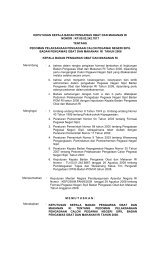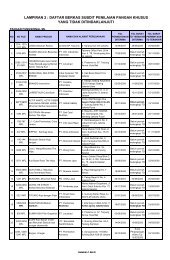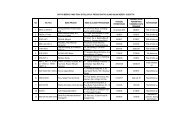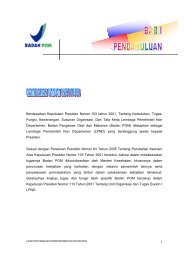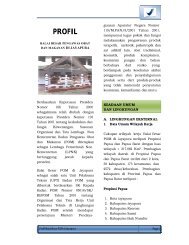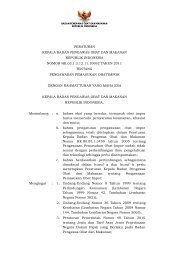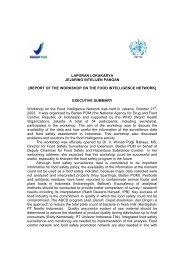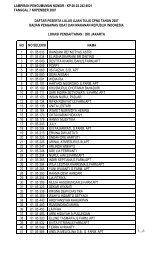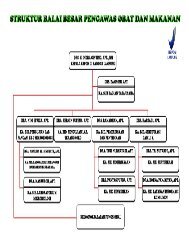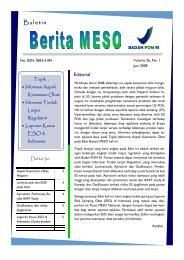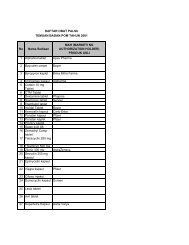Badan Pengawas Obat dan Makanan Republik Indonesia ...
Badan Pengawas Obat dan Makanan Republik Indonesia ...
Badan Pengawas Obat dan Makanan Republik Indonesia ...
- No tags were found...
Create successful ePaper yourself
Turn your PDF publications into a flip-book with our unique Google optimized e-Paper software.
Aneks 1 – Pembuatan Produk SterilVolume sampel tidak perlu samadengan jumlah sampel untuk tujuanklasifikasi dari ruang bersih <strong>dan</strong> saranapenghasil udara bersih.14. Pada zona Kelas A <strong>dan</strong> B, pemantauanjumlah partikel ukuran > 5,0 µm menjadipenting karena merupakan sarana untukdeteksi dini kegagalan.Partikel ukuran > 5,0 µm ka<strong>dan</strong>g-ka<strong>dan</strong>gdapat terdeteksi yang merupakanpembacaan semu, hal ini disebabkanoleh lonjakan elektris, stray light,kejadian tidak terduga <strong>dan</strong> lain-lain.Namun, pembacaan partikel dalamjumlah rendah yang terjadi secaraberurutan ataupun terus-menerusmerupakan indikasi kemungkinan terjadipencemaran <strong>dan</strong> perlu diinvestigasi.Kejadian tersebut merupakan indikasidini kegagalan pada sistem tata udara,mesin pengisi atau merupakan indikasidari kebiasaan yang kurang sesuaiselama perakitan alat <strong>dan</strong> kegiatan rutin.15. Jumlah partikulat seperti yang tercantumpada tabel di atas untuk keadaan “nonoperasional”,setelah kegiatan selesai<strong>dan</strong> tanpa personalia, hendaklah dicapaisegera setelah waktu pembersihan yangberkisar antara 15 – 20 menit (angkaacuan).16. Pemantauan area Kelas C <strong>dan</strong> D padasaat kegiatan rutin hendaklah dilakukansesuai dengan prinsip manajemen risikomutu. Persyaratan batas waspadaataupun batas bertindak tergantungpada jenis proses yang dilakukan, tetapi“waktu pemulihan” yangdirekomendasikan hendaklah tercapai.17. Parameter lain misal suhu <strong>dan</strong>kelembaban udara akan tergantungpada jenis produk <strong>dan</strong> proses yangdilakukan. Parameter ini hendaklah tidakmemengaruhi kelas kebersihan yangdipersyaratkan.18. Contoh kegiatan yang dapat dilakukandi berbagai kelas (lihat juga Butir 28 -35):Annex 1 – Manufacture of SterilePharmaceutical Productsnecessary for the sample volume to bethe same as that used for formalclassification of clean rooms and cleanair devices.14. In Grade A and B zones, the monitoringof the ≥ 5.0 µm particle concentrationcount takes on a particular significanceas it is an important diagnostic tool forearly detection of failure. The occasionalindication of ≥ 5.0 µm particle countsmay be false counts due to electronicnoise, stray light, coincidence, etc.However consecutive or regularcounting of low levels is an indicator of apossible contamination event andshould be investigated. Such eventsmay indicate early failure of the HVACsystem, filling equipment failure or mayalso be diagnostic of poor practicesduring machine setup and routineoperation.15. The particle limits given in the table forthe “at rest” state should be achievedafter a short clean up period of 15 - 20minutes (gui<strong>dan</strong>ce value) in anunmanned state after completion ofoperations.16. The monitoring of Grade C and D areasin operation should be performed inaccor<strong>dan</strong>ce with the principles of qualityrisk management. The requirements andalert/action limits will depend on thenature of the operations carried out, butthe recommended “recovery time”should be attained.17. Other characteristics such astemperature and relative humiditydepend on the product and nature of theoperations carried out. Theseparameters should not interfere with thedefined cleanliness standard.18. Examples of operations to be carried outin the various grades are given in thetable below (see also paragraphs 28 to35):Edisi 2009 - 18 - 2009 Edition



